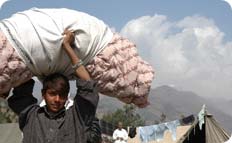Recent Additions
Related Projects
- Mainstreaming
- Risk Analysis
- Recovery
- Risk Transfer & Private Sector
- Research & Learning
- Cost benefit analysis
- ProVention Publications
- Partner Libraries & Resources Centres
- Community Risk Assessment Toolkit
- Other resources
- Monitoring & Evaluation
- Characteristics of a Resilient Community
- Climate Change Adaptation
- Videos
 |
|
Recovery |

Reducing risks in recovery
Recognising that post-disaster recovery often bridges across both emergency relief and long-term development, ProVention is focused on making the often posited ‘window of opportunity’ in recovery for long-term risk reduction significantly more feasible. Key to this feasibility is the development and sharing of tools and resources for effective risk reduction.
Together with the World Bank ProVention has published a set of Recovery Lessons Learned studies which address system-wide policy and practice issues to be considered in recovery planning and operations.
Building on these analytical studies, ProVention is interested to examine how lessons learned are currently being applied, or not, to reduce risks. Together with ALNAP, ProVention produced two lessons learned papers after the South Asia Earthquake in an effort to highlight critical issues and past learning in a timely manner to inform ongoing relief and recovery operations decision-making.
In particular, ProVention’s interest in recovery is in better grounding the conventional wisdom that recovery automatically represents a ‘window of opportunity’ for risk reduction by developing and promoting tools for better assessing, designing, and implementing such opportunistic strategies as well as analysing the obstacles for linking risk recovery to risk reduction.
In addition, ProVention will seek to disseminate and integrate other ProVention resources, such as the mainstreaming tools, GRIP information and data, community risk assessment methodologies and risk transfer mechanisms, all of which are extremely relevant to the recovery process. ProVention’s active participation in the International Recovery Platform is considered a key opportunity for such knowledge sharing activities.
Key issues & gaps
While there has been significant interest in lessons learned over the years, often these efforts have been internally focused within particular agencies and organisations. Missing are :
- a better understanding of how the full context in which risk reduction activities are undertaken affects the outcomes of those activities.
- critical analyses to explore the dynamics of how investments in risk reduction are perceived and implemented. Key areas of interest are risk perception, cost-benefit analysis, integration of risk reduction into other planning tools, trade-offs in decision-making, and policy prioritisation.
- broad longitudinal analysis over time to better understand the true impacts of risk reduction measures.
In addition, much of the dialogue and background around recovery that is widely available comes from international NGOs, donor government agencies, or the UN. As part of an ongoing commitment to promote broader sharing of knowledge and information by and among researchers and practitioners in the developing world, ProVention is also very interested to support increased participation and visibility of organisations from the South in the risk reduction dialogue.
Resources available on this website:
Recovery studies from past disaster responses
In 2004-2005, the World Bank published three case studies from the 'Learning Lessons from Disaster Recovery' study originally started in 2002. These case studies identify lessons learned from the following disasters:
- Recovery study: Bangladesh - floods 1998
- Recovery study: Honduras - Hurricane Mitch 1998
- India - Gujarat earthquake 2001 (unpublished working paper)
- Recovery study: Mozambique - floods 2000 and 2001
- Turkey - earthquakes of 1999 (unpublished working paper)
Lessons from evaluations of relief and recovery responses
ProVention-ALNAP publications:
- ProVention-ALNAP publication: Responding to earthquakes 2008 - Learning from earthquake relief and recovery operations
- Flood disasters: Learning from previous relief and recovery operations
- Slow-onset disasters: drought and food and livelihoods insecurity – Learning from previous relief and recovery responses
- South Asia Earthquake 2005: Learning from Previous Earthquakes recovery and relief operations
IFRC recovery studies:
- Rebuilding after Hurricane Mitch: Housing reconstruction in Honduras and Nicaragua
- Community participation in rebuilding in the Maldives
- Supporting communities to rebuild in Sri Lanka
Other resources
Portals
- The Shelter Centre supports transitional settlement and reconstruction with communities affected by conflict and natural disasters. To that end, the Shelter Centre works with all stakeholders in the shelter sector to improve capacity, coordination and good practice.
- the Database of Good Practice on Recovery maintained by the International Recovery Platform
- the Vulnerability Reduction & Sustainable Environment section of the UNDP website
Forums
Conferences
Reports
- Community-driven reconstruction: a new strategy for recovery (Humanitarian Exchange, ODI/HPN, 2008)
- Guidelines for Cash Transfer Programming (IFRC/ICRC, 2007)
- Tsunami Evaluation Coalition synthesis report
- Housing reconstruction after conflict and disaster, network paper 43 from the Humanitarian Practice Network
- Christian Aid’s “Facing up to the storm” report (July 2003) - How local communities can cope with disaster: lessons from Orissa and Gujarat
- Technology, Post-Disaster Housing Reconstruction and Livelihood Security (Twigg, 2002)
- Holistic Disaster Recovery: Ideas for Building Local Sustainability after a Natural Disaster. (NHRAIC, 2001)
- Community Participation in Post-disaster Reconstruction. Lessons Learned from the Maharashtra Emergency Earthquake Rehabilitation Program. (World Bank)
- the Rehabilitation and Reconstruction guide (Aysan and Davis, 1993) from the UNDP/DHA Disaster Management Training Programme